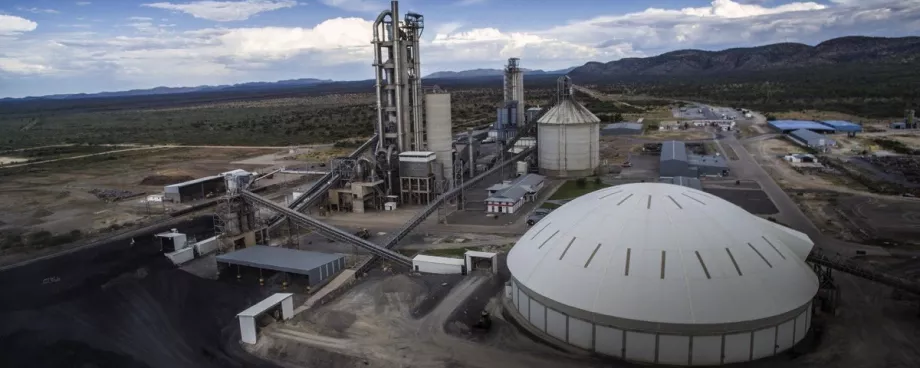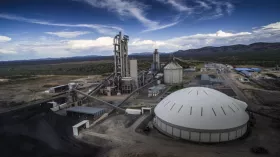
According to an old saying in the construction industry there is always “someone building something somewhere”. Whether in North America, Asia or Africa: large infrastructure projects require more and more material for buildings, streets, airports, bridges or dams. Since 1990, global cement production has almost quadrupled. Worldwide, some 4.17 billion tons were produced in 2016. This growth is mainly due to the development of the Asian markets, especially China. Nevertheless, despite growing cement sales, cement manufacturers all over the world face production overcapacities that have been built up during recent years especially in China, exerting enormous pressure on cement and clinker prices worldwide. Due to these overcapacities, some countries focused more on the export of cement and clinker, an intermediate product of the cement production. At the same time, an increasing number of countries decide to import cement or clinker, instead of producing it domestically.
In 2016, more than 150 countries imported cement and clinker. One of these countries is Australia. Brisbane, for example, the metropolis on the Pacific coast, is one of the fastest growing cities on the continent. Its population of about 2 million inhabitants is expected to double by 2056. Construction sites all over the city centre are witness to this progress, with skyscrapers mushrooming. Due to their strict environmental regulations and price pressures, Australia imports an increasing part of their demand for cement and especially clinker. The clinker is imported and then ground down to cement in Australia. The imported materials are coming from multiple countries including Indonesia, China and Vietnam. These imports are increasingly replacing the local production: in 2016, the utilisation of the domestic cement production capacities was only at around 57 percent.
Less environmental Impacts, increased Energy Efficiency
When producing cement large quantities of carbon dioxide are emitted worldwide. These emissions occur during various processes, but the majority comes from emitting the CO2 from the limestone used to produce cement clinker. Depending on the processes used, the carbon dioxide emissions from producing cement are at 0.6 - 0.99 t of CO2 per ton of cement. Emissions from cement production are estimated to account for seven to eight percent of the overall global carbon dioxide emissions. Manufacturers can reduce these large quantities for example by partially substituting the cement clinker with alternative materials such as fly ash, clay or granulated blast-furnace slag. Another approach to sustainably reduce greenhouse gas emissions and production costs is to increase the use of alternative fuels for the cement production.
The alternative fuels are used as sources of energy instead of fossil fuels like coal and gas. Besides liquid materials like waste oil or solvents, the majority of the solid alternative fuels are composed of municipal and industrial waste, such as plastic, paper, composite material or textile mixes. Whole or shredded waste tyres are also used and made up 6 % of the alternative fuels used in Germany for the production of cement in 2016. The calorific value of waste tyre rubber is comparable to that from hard coal, and the iron from the reinforcement can be incorporated mineralogically into the cement. This minimises the addition of ferrous corrective substances.
Systems adapted to the Production
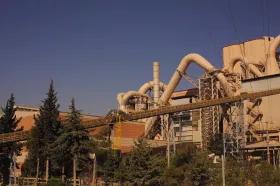
As a system supplier, Beumer Group develops tailor-made solutions perfectly adapted to meet cement plant requirements: conveying systems such as troughed belt conveyors and pipe conveyors, different bucket elevator types and clinker transport systems, loading systems and complete packaging lines, and provides these solutions throughout the entire material flow chain from unloading the delivery vehicle to storing, taking samples, conveying and control feeding solid alternative fuels including fully automated systems that can control feed, singulate and convey large and heavy tyres to the inlet of the rotary kiln. The company also provides innovative intralogistic solutions to international cement companies who are looking for sustainable and cost-efficient ways to modernise their plants. Aalborg Portland A/S, for example, relies on such a solution. Beumer provided a complete system so that the cement manufacturer can recover energy from various types of waste at its Dannish plant which needs different types of alternative fuels in the calciner and in the main burner. These fuels of differing composition are efficiently stored, conveyed and fed.
The customer received all the equipment from a single source, and needed only one contact. The oven-ready alternative fuels are delivered in moving-floor trailers which are unloaded into a temporary intermediate storage at the receiving station. The production lines receive the pre-processed material from the storehouse via recently modernised moving floors and a newly nstalled pipe conveyor that feeds the calciner and the main burner. As the heart of this system the pipe conveyor provides a quiet, energy efficient and low-maintenance means of transport In addition, the system is emission-free because the enclosed construction prevents material from falling and dust and odours from escaping into the environment. With its ability to navigate curves, the pipe conveyor requires considerably less transfer points in comparison to other belt conveyors. This allows for substantial capital cost savings for the customer and the supplier can customise the system to the individual routing.
Energy saving and environmentally friendly Transport

The Beumer Group belt conveyors, pipe conveyors and open troughed belt conveyors, are particularly suited for transporting bulk material through rough terrain. The overland conveyors come with horizontal and vertical curves, depending on the topography, and can be over 10 kilometres long. Angles of inclination of up to 15 degrees are possible, depending on the characteristics of the material to be transported. The throughput capacity of these conveying systems can be up to 10 000 tons per hour. Trucks are still frequently used for greater distances. Depending on the nature of the terrain, however, they can rapidly reach their limits as they require well-developed roads and fuel, for example. The costs arising for construction, maintenance and possible extension of these roads are not insignificant. In addition, all of this implies serious landscape changes. The emissions caused by truck traffic are high, both with regard to toxic substances and to noise and dust.
The Beumer belt conveyors are provided with environmentally safe electric drives and low-energy belts. Therefore, they are considered a ‘preferred option’, especially with regard to climate change and increasing greenhouse gas emissions. The electric motors - which, depending on the topography are run in either drive or regeneration mode - are mostly adjustable. This permits an optimum load distribution on the drive unit in different operating modes. If the belt conveying system conveys downhill, the system works in generative operation. The generated electric energy is fed back into the public network by a regenerative feedback unit. This way the operating costs of the complete system can be further reduced.
Straight up
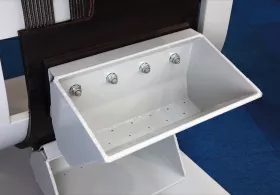
For vertical conveying, bucket elevators are state-of-the-art. Beumer Group provides different types of bucket elevators with low investment costs, a long service life and easy maintenance to ensure cost-efficient utilisation. Thanks to consistent development, customers can be provided with an optimum solution, whether with belt or chain bucket elevators. Until recently, the use of belt bucket elevators was generally limited to transporting fine bulk material, because there was a risk on the older models that coarse-grained bulk material could get stuck between the bucket and the belt and thus damage the belt. In the course of consistent development work, Beumer Group could introduce the innovative high-capacity belt bucket elevator type HD (heavy duty). This bucket elevator makes it now possible to efficiently transport even coarse-grained material such as clinker. The elevator is designed to eliminate the space between the individual buckets and the belt. This prevents coarse material from getting stuck during the scooping and filling process and from damaging the belt. At the same time, it holds the same proven advantages of belt-based bucket elevators for the customer, such as the very high conveying capacity, prolonged service life of the belt and less noise generation. In addition, the company is also well-positioned in the field of chain-based bucket elevators and its central chain bucket elevators offer highly-efficient technology for the vertical transport of coarse, hot or abrasive bulk material.
Packaging for Safe Transport
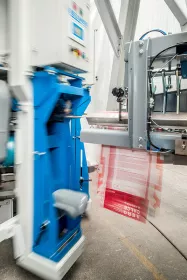
The greatest part of the costs of cement arises only after its final completion in the silo, namely for the distribution to intermediate storage and to final users. Cement is transported in bulk and in bags. The majority of cement worldwide is loaded in bulk via terminals into road and rail vehicles or into ships. The remaining, not insignificant part of the material is transported in bags, which necessitates bagging of the cement, palletising the bags and packing the pallets for further transportion to the customer, often over great distances. For all the steps of the latter transportation process Beumer Group provides the necessary machinery. This includes the fillpac R bagging system which operates according to the impeller filling principle. Its weighing electronics make it unique. The product is filled according to the gross weight principle, i.e. the bags are weighed during the filling process. The associated weighing electronics ensures exact filling levels of the bags. The system is complemented by Beumer’s bag placer and a state-of-the-art bag bundle magazine.
Fully automatic paletpac layer palletisers then stack the bags reliably with a capacity of 5500 bags per hour. The systems can be equipped with a twin-belt turning device, to turn the bags to the required position fast, gently and without affecting their dimensions. Its intelligent control involves the dimensions and weights of the bags in order to achieve an exact positioning preset by the respective packing pattern. The finished bag stacks are then transported via roller conveyors to Beumers stretch hood A packaging system.
Loading and Palletising combined
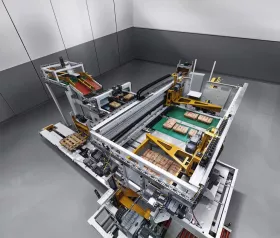
In order to further reduce costs, a trend towards higher levels of automation in the packaging and loading of cement is evident also in emerging markets such as India., for example. In order to fully automatically load the bagged bulk material on trucks, Beumer Group offers its autopac loading and palletising system, that can load up to 3000 bags per hour without any problems. The machine simultaneously loads and stacks bagged goods directly on trucks, pallets are not necessary. This system makes the loading of bags on trucks particularly efficient and cost-effective. Utilising this system can help save labour during the otherwise labour-intensive loading of cement bags. Beumer Group products are also suitable for loading waggons and ships. Their machines and systems help cement manufacturers worldwide to produce efficiently despite increasing cost pressure and strict environmental regulations.
■










